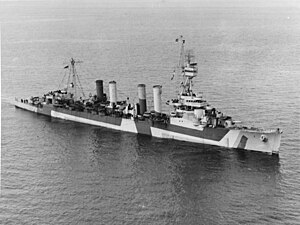 USS Detroit (April 1944)
| |
| History | |
|---|---|
| Name | Detroit |
| Namesake | City of Detroit, Michigan |
| Ordered | 4 March 1917 |
| Awarded |
|
| Builder | Bethlehem Shipbuilding Corporation's Fore River Shipyard, Quincy, Massachusetts |
| Laid down | 10 November 1920 |
| Launched | 29 June 1922 |
| Sponsored by | Miss M. Couzens |
| Completed | 1 November 1921 |
| Commissioned | 31 July 1923 |
| Decommissioned | 11 January 1946 |
| Stricken | 21 January 1946 |
| Identification |
|
| Fate | Sold for scrap 27 February 1946 |
| General characteristics (as built) | |
| Class and type | Omaha-class light cruiser |
| Displacement | |
| Length | |
| Beam | 55 ft (17 m) |
| Draft | 14 ft 3 in (4.34 m) (mean) |
| Installed power |
|
| Propulsion |
|
| Speed | |
| Crew | 29 officers 429 enlisted (peace time) |
| Armament |
|
| Armor |
|
| Aircraft carried | 2 × floatplanes |
| Aviation facilities | |
| General characteristics (1945) | |
| Armament |
|
USS Detroit (CL-8) was an Omaha-class light cruiser, originally classified as a scout cruiser, of the United States Navy. She was the fourth Navy ship named for the city of Detroit, Michigan. She spent her first eight years as part of the Scouting Fleet either in the Atlantic or Mediterranean. Her first duty was to assist in the USAAS's first aerial circumnavigation of the world in 1924 and transported the United States Secretary of State Frank B. Kellogg, in 1927, from Ireland to France for the negotiations that led to the signing of the Kellogg-Briand Pact. In 1931 she joined the Battle Force, where her home port was San Diego until moving to Pearl Harbor in 1941. Detroit was moored next to her sister Raleigh when the Japanese attacked on the morning of 7 December 1941.